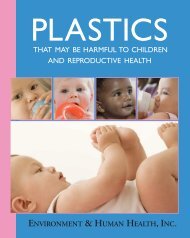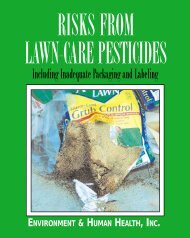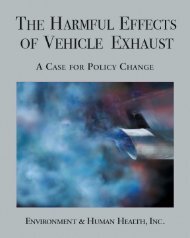LEED Report - Environment & Human Health, Inc.
LEED Report - Environment & Human Health, Inc.
LEED Report - Environment & Human Health, Inc.
- No tags were found...
Create successful ePaper yourself
Turn your PDF publications into a flip-book with our unique Google optimized e-Paper software.
The Green Building DebateRecommendations for theFederal GovernmentThe effectiveness of the Green Building Council’s (GBC) <strong>LEED</strong> program and the legitimacyof <strong>LEED</strong> certification critically depend upon the ability of developers to be ableto identify hazardous chemicals in the built environment, and to prevent dangerousexposures. New federal law will be necessary to accomplish this. The failures of theToxic Substances Control Act (TSCA), described previously in this report, must be corrected.We suggest the following key provisions for a national healthy building policy.■N a t i o n a l B u i l d i n g P r o d u c tC h e m i c a l R e g i s t r yThe Green Building Council could not possibly be expected to keep track ofthe chemical content of all available building materials. The federal governmentshould assume this responsibility and maintain a national registry of thecomposition of building products, furnishings and cleaning products.The registry should also be used to record and update chemical testing statusand product recyclability. The federal government should also create andmaintain a single database that identifies chemical toxicity, level of hazard,common sources of exposure, and an assessment of the adequacy of data usedto support these classifications. The best model for keeping these records isthe Agency for Toxic Substances and Disease Registry’s “Toxicological Profiles.”■C h e m i c a l Te s t i n gAll chemicals used to form building products should be tested to understand:a) the hazards they pose to human health; and b) their environmental fate.New chemicals should be tested to be sure they meet safety standards beforeentering commerce. Existing chemicals should also be tested, while nearly60,000 are currently exempted from testing under TSCA provisions.Given the enormity of the chemical testing problem, EPA should focus onthose chemicals that meet most of the following: a) basic toxicity testing;b) persistence and bioaccumulation; c) demonstrated and common presencein indoor air, water supplies, building products and human tissues; d) volumeof chemical produced annually; e) plausibility of relation to human illness; andf) structural similarity to substances known to induce illness in humans.56







